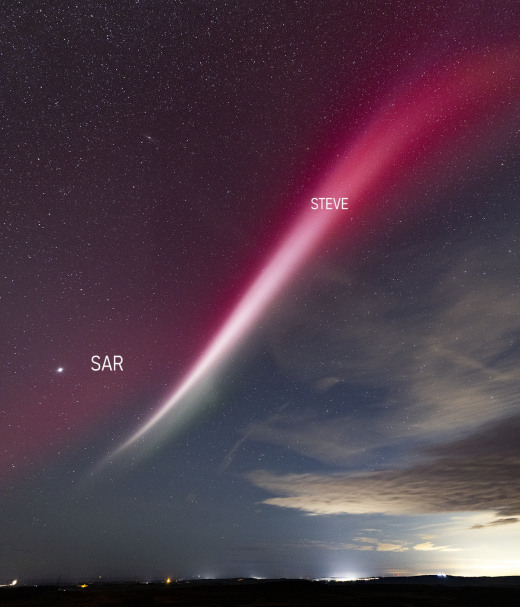Nov. 6, 2023: (Spaceweather.com) During this past weekend’s strong G3-class geomagnetic storm, low-latitude auroras spread as far south as Texas and Arizona. Upon further review, most of those lights were not auroras at all. Everything red in this montage is an “SAR arc”:

Credits: Texas (Anita Oakley); Missouri (Dan Bush); New York (James Perez-Rogers); Arizona (Jeremy Perez)
“This was a new phenomenon to me,” says Jeremy Perez, who took the Arizona picture. “I had never heard of SARs before, but I kept shooting anyway.”
SAR arcs were discovered in 1956 at the beginning of the Space Age. Researchers didn’t know what they were and unwittingly gave them a misleading name: “Stable Auroral Red arcs” or SAR arcs. In fact, SAR arcs are neither stable nor auroras.
Auroras appear when charged particles rain down from space, hitting the atmosphere and causing it to glow. SAR arcs form differently. They are a sign of heat energy leaking into the upper atmosphere from Earth’s ring current system–a donut-shaped circuit carrying millions of amps around our planet.

An artist’s concept of Earth’s ring current, quiet (left) and active (right) [more]
“On Nov. 5th, the ring current was pumped up by hours of strong geomagnetic storming, with energy dissipating into these SAR arcs,” says Jeff Baumgardner of Boston University’s Center for Space Physics. “It was a global event. Our cameras registered SAR arc activity from Italy to New Zealand.”
Recent research has linked SAR arcs to another phenomenon that is not an aurora: STEVE. The mauve ribbon in the sky was not originally thought to have anything to do with Earth’s ring current. Yet in 2015, observers in New Zealand caught a bright red SAR arc transforming itself into STEVE like a caterpillar into a butterfly.
On Nov. 5th, Mark Savage may have witnessed the same metamorphosis over Northumberland, UK:

Visible to the naked eye, STEVE materialized from an overhanging red arc. “The entire process took about 10 minutes,” says Savage. This timescale roughly matches that of another SAR-to-STEVE transition observed over Canada in April 2022. Clearly, the two phenomena are linked, but researchers aren’t sure how.
“The connection is still elusive,” says Carlos Martinis, a leading researcher in the field at Boston University. “Sometimes SAR arcs evolve into STEVE–but not always. This is a very active field of research, involving citizen scientists and researchers.”
Did you see an SAR arc on Nov. 5th? Submit your pictures here.
more SAR images: from Greg Redfern of Shenandoah National Park, Virginia; from Dean Cosgrove near Stockville, Nebraska; from Chris Cook of Borrego Springs, California; from Todd Bush of Banner Elk, North Carolina; from Ronnie Sherrill of Troutman, North Carolina; from George Preoteasa of Milford, PA; from David Blanchard of Wupatki National Monument, Arizona; from Hunter Outten of Laurel, Delaware; from Caryl Bohn of West Oak, Nebraska; from Ken Sklute of Phoenix, Arizona; from Bernhard Deufel of Horgen, Switzerland; from Klaus Steinberg of Troisdorf, Germany; from Bernhard Deufel of Horgen, Switzerland